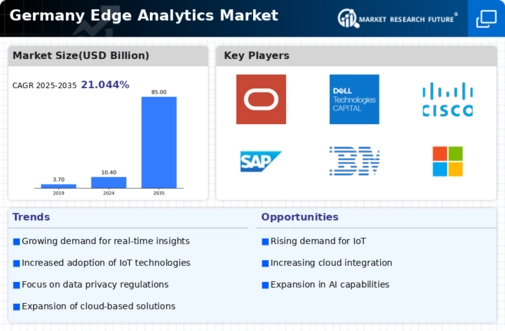Expansion of 5G Infrastructure
The rollout of 5G technology across Germany is significantly influencing the edge analytics market. With its promise of ultra-low latency and high-speed connectivity, 5G enables more devices to connect and communicate in real-time. This technological advancement is expected to enhance the capabilities of edge analytics solutions, allowing for more sophisticated data processing at the edge. By 2025, the number of 5G connections in Germany is projected to exceed 50 million, creating a fertile ground for the edge analytics market to thrive. The integration of 5G with edge analytics can lead to improved performance in applications such as autonomous vehicles, smart cities, and industrial automation, thereby driving further investment and innovation in the sector.
Increased Focus on Operational Efficiency
Organizations in Germany are increasingly prioritizing operational efficiency, which is driving the growth of the edge analytics market. By leveraging edge analytics solutions, companies can optimize their processes, reduce costs, and enhance productivity. In 2025, it is anticipated that businesses will allocate over €500 million towards edge analytics technologies aimed at improving operational workflows. The edge analytics market plays a crucial role in this transformation, as it allows for the analysis of data generated by machines and devices in real-time, leading to actionable insights. This focus on efficiency is particularly evident in sectors such as logistics and manufacturing, where the ability to make data-driven decisions can lead to significant competitive advantages.
Regulatory Compliance and Data Sovereignty
In Germany, regulatory compliance and data sovereignty are becoming increasingly critical, influencing the edge analytics market. With stringent data protection laws such as the GDPR, organizations are compelled to adopt analytics solutions that ensure compliance while maintaining data integrity. By 2025, it is projected that companies will invest around €300 million in edge analytics technologies that prioritize data security and compliance. The edge analytics market is thus adapting to these regulatory demands, offering solutions that allow organizations to process and analyze data locally, thereby mitigating risks associated with data breaches and ensuring adherence to legal requirements. This focus on compliance not only protects organizations but also builds trust with consumers.
Rising Demand for Real-Time Data Processing
The edge analytics market in Germany is experiencing a notable surge in demand for real-time data processing capabilities. As industries increasingly rely on instantaneous insights to drive decision-making, the need for edge analytics solutions becomes more pronounced. In 2025, it is estimated that the market for edge analytics in Germany could reach approximately €1.5 billion, reflecting a compound annual growth rate (CAGR) of around 25% from previous years. This growth is largely driven by sectors such as manufacturing, healthcare, and transportation, where timely data analysis is critical for operational efficiency. The edge analytics market is thus positioned to capitalize on this trend, providing solutions that enable organizations to process data closer to the source, thereby reducing latency and enhancing responsiveness.
Growing Adoption of Smart Manufacturing Practices
The edge analytics market in Germany is being propelled by the growing adoption of smart manufacturing practices. As industries embrace Industry 4.0 principles, the integration of edge analytics becomes essential for monitoring and optimizing production processes. In 2025, the smart manufacturing sector is expected to invest approximately €1 billion in edge analytics solutions, reflecting a strong commitment to innovation and efficiency. The edge analytics market is thus positioned to support manufacturers in harnessing data from IoT devices and sensors, enabling real-time monitoring and predictive maintenance. This shift not only enhances productivity but also contributes to sustainability efforts by minimizing waste and energy consumption.

















Leave a Comment